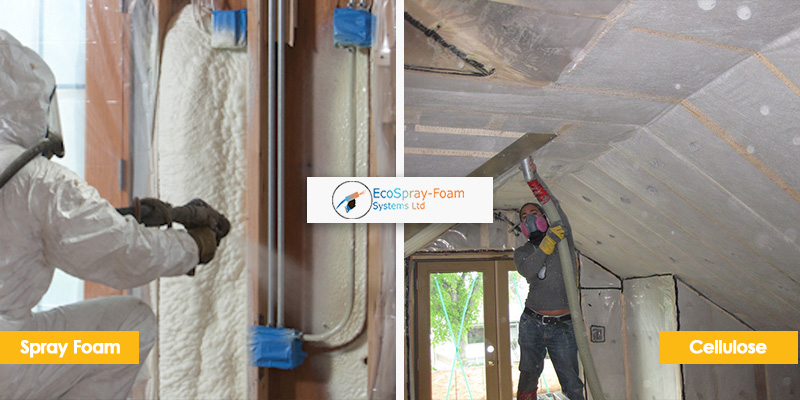
Spray Foam vs Cellulose Insulation – What to Pick?
Both spray foam and cellulose insulation are two dominant products that homeowners and commercial property owners invest in for their insulation needs. It can be tricky choosing the best insulation material for the job, however, at EcoSpray Foam Systems, we like to make this task a whole lot easier by not only comparing insulations for you but recommending our preferred solutions for different tasks.
Whether you want insulation for your cavity walls, roof, floors, solid walls, or anything else, our experts can recommend the best solutions to meet your objectives. In this article, we will be comparing two common types of insulation, spray foam and cellulose, understanding their pros and cons and coming to an agreement on the best type for you.
What is Spray Foam Insulation?
Spray foam in an insulation product that is applied via a spraying format, once it hits the relevant surface, this insulation expands into a foam-like substance. Some forms of foam insulation can expand up to 100x in size from its original state.
Importantly, spray foam comes in 2 main forms, closed-cell foam and open-cell foam. Both of these types of insulation consistent of benefits that can help you with your next insulation project, whether you want the best thermal insulation possible, soundproofing or added structural integrity, this insulant can do it all.
What are the Pros & Cons of Spray Foam Insulation?
Pros of using Spray Foam
1. Choice
Using spray foam insulation, you can choose between open-cell and closed-cell. This choice allows you to pick the better product for the job. Open-cell expands more, easily covers nooks and crannies, and has good soundproofing properties. Whereas, closed-cell has a lower U-Value, aids to structural integrity and is water impermeable due to its closed cell structure.
2. Easily Applied
For areas that have lots of nooks and crannies, tight spaces and hard-to-reach spot, it can be difficult to provide sufficient insulation. However, due to the expanding properties of open-cell foam insulation, it can be much easily sprayed into these areas, covering everything needed with effective insulation.
3. Low U-Value
Spray foam, especially closed-cell foam, has a low U-Value, which means heat transmits through the material slowly, performing better as an insulator. Moreover, this also means that less energy is required to maintain your ideal conditions inside your home or property. The better the thermal insulation the lower your carbon emission output and the lower your energy bills will be.
Cons of using Spray Foam
1. Cost
Spray foam, in comparison to cellulose, is a bit more expensive as an investment. Due to the benefits spray foam has, this insulation product has a higher price than that of cellulose insulation.
What is Cellulose Insulation?
Cellulose insulation is a type of fibre insulation that is commonly used in cavity walls and cavities in general and loft floors. The components of cellulose consist of small particles, such as recycled paper or recycled denim, making it an eco-friendly insulation alternative.
Cellulose insulation can also be blown-in as loose-fill insulation, helping to fill small cavities, or it is also provided in pre-packed forms, to be easily placed into walls and floors.
What are the Pros & Cons of Cellulose Insulation?
Pros of using Cellulose
1. Eco Friendly
Cellulose consists of between 75%-85% of recycled materials, making it one of the eco-friendlier insulation materials available on the market. This type of cellulose is especially used in commercial insulation projects.
2. Inexpensive
Compared to spray foam, cellulose is an inexpensive form of insulation, allowing you to complete your projects with less upfront costs.
3. Fire Retardant
Blown-in cellulose insulation is also fire-retardant, this is a huge safety bonus for the insulation product.
Cons of using Cellulose
1. Higher U-Value
The thermal capability of using cellulose insulation is worst than spray foam, requiring more energy consumption to find that comfort inside your building.
2. Short-Lived
Over time loose insulation can settle, this may end up creating cold or hot pockets of air and further lessening the effects of the insulation product. The settling of cellulose can be as much as 20% of the insulation, which makes it a less effective long-term solution.
3. Can't Get Wet
Cellulose needs to stay dry, due to the paper composition; it absorbs up to 130% water by weight. It also dries very slowly after absorbing water, which can spur on issues of settling and deterioration afterwards.
Conclusion
If you wish for a short-term and initially cheaper form of insulation, then cellulose can do the job. It is eco-friendly, helps with soundproofing, fire retardant and has lower initial costs than spray foam insulation.
If you wish to insulate with a more long-term, energy saving and better thermal resistant insulation, then spray foam is your best bet. It has a lower U-Value, can soundproof and importantly, lasts as long as your property, saving you money on energy bills every month.


